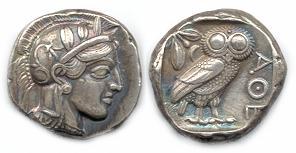| REFERENCE INDEX | HOME | SALES GALLERY |
ATHENA
 |
Athena was born the daughter of Zeus and his first wife, Metos (Wisdom). The myth of her birth is a little unusual in that Zeus had been advised that any children he had by Metos would be very powerful and eventually dethrone him. As Metos was about to give birth, Zeus swallowed her, but was soon tortured by a severe headache. As a cure, Hephaestus split his skull with an ax and from the wound sprang a fully armed Athena.
Athena was a major Greek goddess serving many roles. The earliest representations of Athena (long before coins) were said to have been stones that fell from the sky. This seems to suggest meteorites, which also suggests she may have originated as a lunar goddess. Best known as the patron goddess of the city of Athens, on whose coins she is usually featured, she was a warrior goddess charged with protecting many cities and acropoli. As godess of the arts of peace she was prayed to by sculptors, architects and practitioners of handicrafts such as weaving and spinning. As a goddess of wisdom she adopted the owl as her symbol and watched over assembly in the agora. She also had agriculture duties, responsible for the fruiting of olive trees and charged with the protection of horses and oxen.
She was a virgin goddess and is always represented fully clothed, usually in armour and often holding a spear. The tetradrachm a Athens (illustrated above) shows many of her attributes. On the obverse one sees her head wearing a military helmet symbolizing her warrior aspect as protector of the city. On the reverse is her sacred bird, the owl, symbolizing wisdom and above, to the left, is an olive sprig symbolizing her agricultural duties. Just behind the owl's back is a small crescent moon, supporting the idea that she may have originated as a lunar goddess.
If you entered this page from a coin description, use the back button to return to that position.
Mythology Index
| Main index | Reference Index | Home page |
Copyright © 2000 R & T Enterprises Ltd.